From Spanish flu to COVID-19
MSU's response to pandemics a century apart
The current novel coronavirus pandemic has challenged the Michigan State University community, but it’s not the first time the university has had to respond to such a sweeping threat to human health.
Members of the MSU community came together to help one another through the flu pandemic of 1918, also known as the Spanish flu. Now, more than 100 years later, Spartans from research labs to the front lines of health care are responding to the COVID-19 threat, finding solutions and supporting each other and others around the world.
The 1918 influenza pandemic had a devastating global impact. Nearly half a billion people became infected by the virus, with the number of deaths estimated to be 50 million. In the United States, the virus was first identified in military personnel during the spring of 1918. In the fall of 1918, an all-hands-on-deck response was playing out on the campus of MSU, then Michigan Agricultural College.
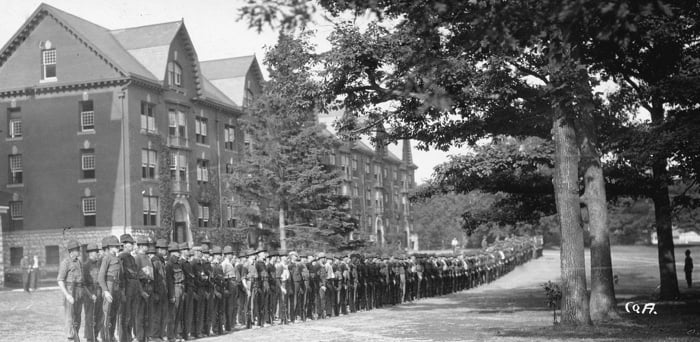
In October 1918, toward the end of World War I, the Student Army Training Corps was established at U.S. colleges, including MAC. Eight temporary barracks and two mess halls were constructed near the Horticultural Laboratory on campus to accommodate as many as 1,400 men who would train to be soldiers. Shortly after the camp opened in early October, the program at MAC was halted with the outbreak of the flu.
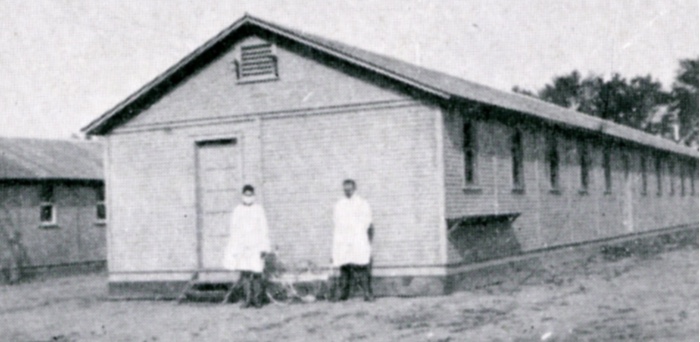
The virus required isolation of sick student soldiers, medical care at the SATC hospital and a quarantine across campus. The quarantine lasted nearly three weeks, with 22 people from campus and the Lansing area dying from the influenza. The SATC program was rendered futile when the end of World War I was declared on Nov. 11, 1918.
Today, the novel coronavirus has continued its spread. On May 28, the U.S. hit the somber milestone of 100,000 deaths related to COVID-19, with over 350,000 fatalities reported worldwide.
While much has changed at MSU, as well as the rest of the world, since the early 20th century, one constant is the university’s dedication to making a healthier, safer campus community and world.
Take a look at how MSU has responded to pandemics — then and now.
Campus life
THEN
In response to the 1918 flu, a quarantine was enacted across MAC’s campus that included all buildings, with the exception of Faculty Row and the Women’s Building on north campus. Sentries guarded two points of entry; one was located between the post office (near where the MSU Union now stands) and Abbot Hall (near the present day Music Practice Building), and the other between the Women’s Building (present day Morrill Plaza) and the library (known today as Linton Hall).
Anyone entering campus required a quarantine pass, a measure meant to help halt the spread of the virus among students on campus.
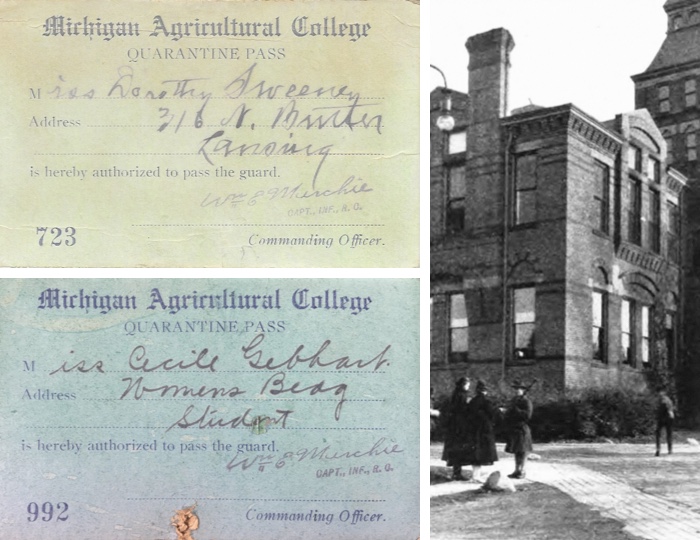
An enlarged quarantine district is now established to include all of the campus except Faculty Row and the Women’s Building. The sentry lines run just south of the Faculty Row drive, east to Farm Lane, and south to the barns, then west to include the shops, Wells, and the new gymnasium. There are but two “ports of entry,” one between the post office and Abbot Hall and the other between the Women’s Building and the library. Absent-minded faculty members are brought up quickly with the sharp “halt” of the sentry if they wander from the beaten paths. — The MAC Record, Oct. 25, 1918
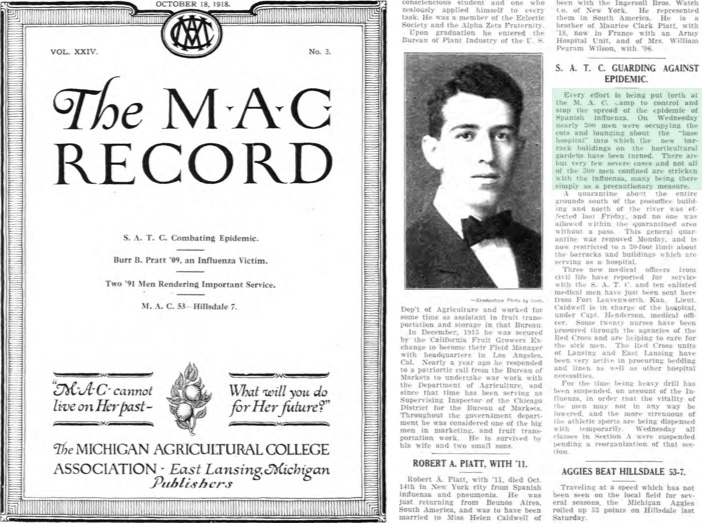
Highlighted above: Every effort is being put forth at the MAC camp to control and stop the spread of the epidemic of Spanish influenza. On Wednesday, nearly 300 men were occupying the cots and lounging about the “base hospital” into which the new barrack buildings on the horticultural gardens have been turned. There are but very few severe cases, and not all of the 300 men confined are stricken with the influenza, many being there simply as a precautionary measure. — The MAC Record, Oct. 18, 1918
NOW
After the first cases of COVID-19 in the state of Michigan were confirmed on March 10, MSU suspended face-to-face instruction on campus, moving toward a virtual learning model for all students on March 11. MSU faculty and staff continued teaching and conducting work remotely, with essential workers remaining on campus. While students were encouraged to return to their permanent places of residence for the duration of spring semester, MSU supported all students needing to stay behind.
As of late March, nearly 2,000 students were still residing on campus. MSU Residential and Hospitality Services provided resources to the Spartans on campus, from increasing cleaning and sanitizing practices in high-traffic areas to keeping dining and market options open. Students were able to access their residence halls and designated dining halls and service centers with their MSU ID cards.
Residence Education and Housing Services built an express checkout process for spring move-out and provided details for summer session housing. For those needing accommodations for the summer, REHS is offering single room assignments in Holmes Hall. To cope with the hot summer months, air conditioners will be made available by request.
 Left: Kim Piper installs a new sign reminding campus to practice social distancing and handwashing. Right: Essential workers have played an important role in the fight against COVID-19 across campus. Custodian Karen Crawford conducts her work in goggles, a mask and gloves.
Left: Kim Piper installs a new sign reminding campus to practice social distancing and handwashing. Right: Essential workers have played an important role in the fight against COVID-19 across campus. Custodian Karen Crawford conducts her work in goggles, a mask and gloves.Protecting others
THEN
Protective gear always has been a key component to keeping medical personnel, patients and the public safe. In an effort to come together as a community, young women from MAC got to work, furnishing the SATC hospital with everything from masks to surgeons’ robes.According to the MAC Record, women from the university and surrounding community sewed hundreds of hospital sheets, pillowcases, surgical masks, handkerchiefs, pajama suits and utility bags in the span of a week.
From Oct. 11 to Oct. 18 the East Lansing women and college girls made and furnished to the SATC hospital 315 sheets, 293 pillowcases, 106 pajama suits, 72 pneumonia jackets, 623 handkerchiefs, 128 cubicles, 45 surgeons’ robes, 324 masks, 15 surgeons’ coats and 262 utility bags. The amount of material turned out in that time is little short of phenomenal, yet it only goes to demonstrate the spirit of the times and what Red Cross workers will do when there is need.— The MAC Record, Oct. 25, 1918
NOW
In response to the COVID-19 pandemic, Spartan faculty, staff and students have collaborated — while practicing social distancing — on the production of 3D-printed medical face shields, bringing protection to those on the front lines of health care. Left: Cora and Jon Walby, pictured at their home, are staff members from the Division of Engineering Computing Services in the College of Engineering. The couple has joined MSU’s collaborative effort to create critically needed personal protective equipment for medical personnel. Right: Nathan Tykocki, assistant professor of pharmacology and toxicology in the College of Osteopathic Medicine, prints and assembles face shields at home.
Left: Cora and Jon Walby, pictured at their home, are staff members from the Division of Engineering Computing Services in the College of Engineering. The couple has joined MSU’s collaborative effort to create critically needed personal protective equipment for medical personnel. Right: Nathan Tykocki, assistant professor of pharmacology and toxicology in the College of Osteopathic Medicine, prints and assembles face shields at home.MSU researchers also have found innovative ways to sanitize and repurpose personal protective equipment with a decontamination process using vaporized hydrogen peroxide. The process is safe to use on masks, goggles, face shields and other safety gear, giving MSU the ability to decontaminate nearly 6,700 per day. Paired with the heating method employed by MSU Extension, which is used to sanitize N95 masks, the university has the capacity to clean nearly 15,000 pieces of PPE per day.
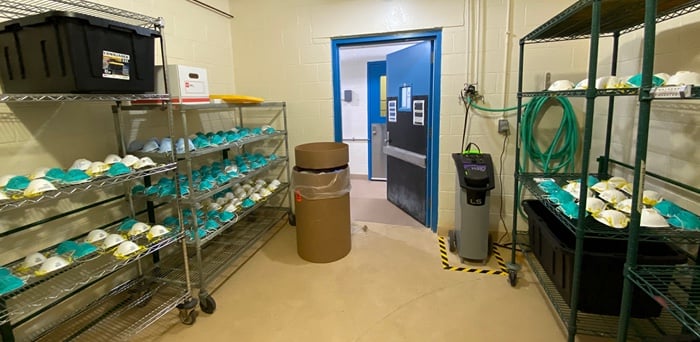
Feeding those in need
THEN
Food and proper nutrition are a critical concern during a pandemic, particularly with a rise in food insecurity. Under the direction of Dean Mary Edmonds, the senior home economics students took over preparing food to be served to sick soldiers. Dean Edmonds recognized the need to help when the regular boarding clubs were overburdened with preparing food for healthy soldiers.
Food was prepared in the home economics laboratories in the Women’s Building and served from the basement of the Horticulture Building.
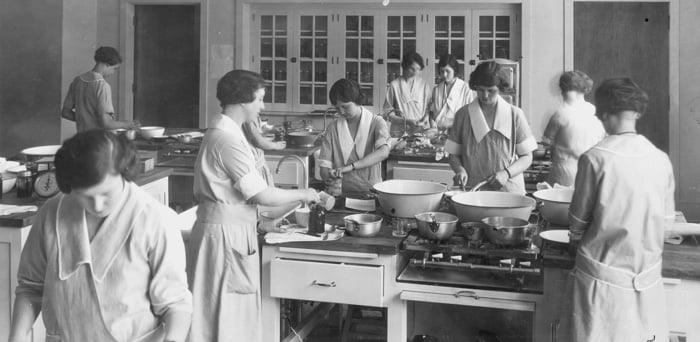
The home economics division of the college has very ably taken over much-needed work in connection with the handling of the influenza situation at MAC and has organized and is operating a dietetics kitchen in which food for all patients in the hospital is prepared and served. The senior domestic science girls are doing the work under the direction of Dean Edmonds and Misses Garvin and Clemens. Up until Saturday of last week the only provision made for feeding the sick men was through the regular boarding clubs. They were already overburdened with the task of preparing food for healthy soldiers and were unable to handle it properly. Then the girls stepped in and took over the task. — The MAC Record, Oct. 25, 1918
NOW
When MSU transitioned to online learning March 11 and encouraged students to return to their permanent places of residence, fewer than 2,500 of the 17,000 students living in residence halls remained on campus. In order to support those students, REHS continued to operate dining halls in neighborhoods across campus; The Edge at Akers, Brody Square, South Pointe at Case and The Vista at Shaw were open to residents.
The dining halls were open for three meals a day, with additional cleaning and sanitizing taking place between lunch and dinner hours. The REHS facilities team also sanitized daily at 4 a.m. to ensure the safety of all students.
 Left: Dining Services Manager Alka Josh prepares MSU Student Food Bank donations in the South Pointe at Case kitchen. Right: Team members came together from a variety of campus neighborhoods to collaborate and prepare meals for donation. This allowed MSU Culinary Services to utilize product and assist the campus and local communities.
Left: Dining Services Manager Alka Josh prepares MSU Student Food Bank donations in the South Pointe at Case kitchen. Right: Team members came together from a variety of campus neighborhoods to collaborate and prepare meals for donation. This allowed MSU Culinary Services to utilize product and assist the campus and local communities.Residential and Hospitality Services found it had a surplus of food items in March, particularly perishable goods, as students left campus and the Kellogg Hotel and Conference Center canceled events. After connecting with the MSU Student Food Bank, the Culinary Services team sorted the goods into more than 450 packaged meals and delivered them to the food bank for distribution.
Staff and volunteers distributed nearly 300 meals to MSU students and families in need. In addition, members of the food bank delivered 150 packaged meals to share with homeless shelters in the Lansing area. Since then, Culinary Services has delivered more than 2,000 meals and food items.
Caring for the community
THEN
With the arrival of the Spanish flu on MAC’s campus, the community rallied together to care for the sick and contain the spread of the virus. Nearly 300 men were confined to barrack buildings on the horticultural gardens as a precautionary measure, while the Phi Delta house on Grand River Avenue was leased by the college as a hospital for women.
Local units of the Red Cross provided crucial assistance to the college. In addition to assigning 20 nurses to help care for the sick men, the Red Cross units of Lansing and East Lansing were active in procuring bedding, linens and other hospital necessities. As noted in The MAC Record, the relief services of the Red Cross were an invaluable contribution to stopping the spread of the Spanish flu on campus.
As secretary of the State Board of Health, Richard M. Olin reviewed the conditions of the influenza on campus. With the situation improving, Olin declared, “Parents of soldiers at MAC do not need to be alarmed. The men are receiving the very best of care, better than they would in their own homes.” Olin became the first full-time college physician and health service director at the college in 1925 and helped design a hospital to address the inadequacies of the medical facilities on campus. Following his death in October 1938, the health center was named in his memory when it opened a year later.

Splendid work has been done by college men and women and military authorities, to care for the sick men of the SATC and check the spread of the epidemic of Spanish influenza. The small number of deaths so far speaks well for the effectiveness of their work and the energy and efficiency with which it has been accomplished. Everyone in the community has done his and her utmost in this emergency. Everywhere, service has been the watchword. Those who have watched the handling of the situation at the MAC camp will not require a trip overseas for a demonstration of what the Red Cross represents and the work that it can do. The Ingham County organization, including the East Lansing unit, have done wonderful work for the college during the past two weeks. Realizing that the boys of the SATC were as much entitled to their services as the men in the hospitals overseas, they came to our assistance at once and have helped mightily in organizing the hospital and caring for the sick men. They have taken care of the situation as no other organization could have done. They were able to put through orders and get materials and supplies, which could not have been obtained without their aid. In many instances their work alone has saved the situation. - The MAC Record, Oct. 25, 1918
Before the Spanish flu subsided, it led to the deaths of 15 members of SATC and a student of veterinary medicine. The toll was considered a small one in comparison with the death rates reported from other posts and cantonments. With the combined efforts of the college, Red Cross and community members, the rate was slightly more than 1%, compared with 6% at Fort Custer near Battle Creek.
NOW
MSU is a local and global community partner in the fight against COVID-19, applying its research capacities and resources to finding solutions on multiple fronts.
Spartans are helping address the health care worker shortage alongside community needs, from announcing the launch of a physician assistant master’s degree program in summer 2021 to students, faculty and professionals from the College of Nursing delivering care on the front lines. As a result of Gov. Gretchen Whitmer’s efforts to increase the speed at which health care professionals can get into the workforce to assist with COVID-19, MSU made available hundreds of health care students who successfully completed their program requirements to Michigan health care systems earlier than usual by expediting their licensure.
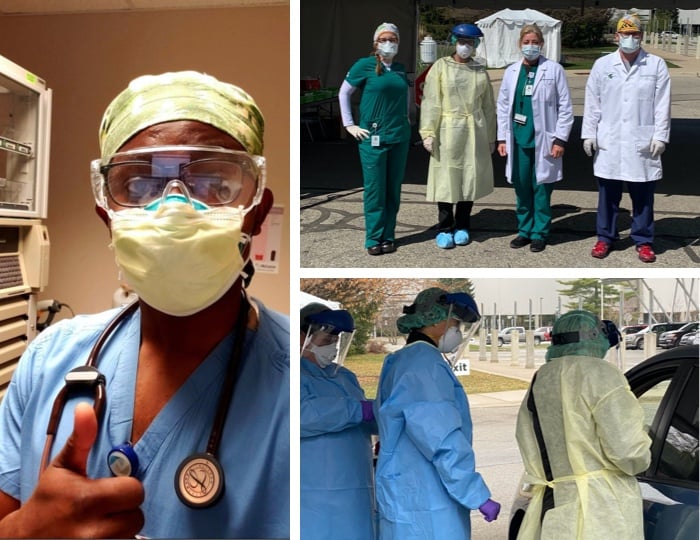
MSU also is working with organizations across the state to help tackle health disparities in the wake of the pandemic. Collaborating with the Ingham County Health Department, City of Lansing, Refugee Development Center and other partners, MSU is conducting tests for the novel coronavirus in areas where testing is not readily available. The first mobile test site, located in south Lansing, has tested more than 100 residents and provided community members with information about how to stay healthy. MSU also offered free drive-through COVID-19 testing to anyone with a physician's order from the beginning of April to early June.
In January, a new initiative led by the MSU College of Nursing and Detroit Medical Center was formed to address health disparities among women of color throughout the state. With the arrival and spread of COVID-19 cases in the state by mid-March, College of Nursing Dean Randolph Rasch was asked by Gov. Whitmer to sit on the Michigan Coronavirus Task Force on Racial Disparities to examine how underserved populations are affected by COVID-19.
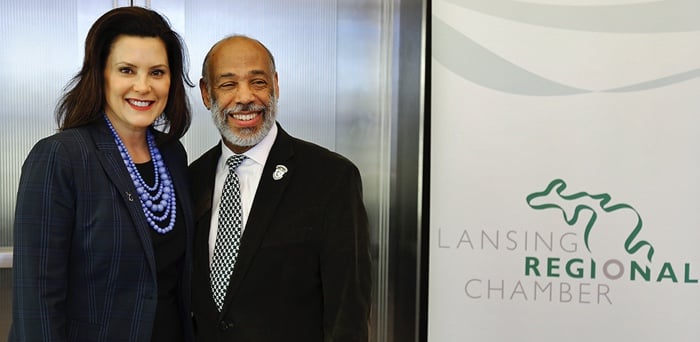
Gov. Gretchen Whitmer and Randolph Rasch, dean of the College of Nursing
As the fight against the disease continues, Spartans and community members will continue to work together and help one another — much as they did more than 100 years ago.
Leading the way — THEN and NOW
From President Frank S. Kedzie's urging to "do your part in the interests of the entire community" in 1918 to President Samuel L Stanley Jr., M.D.'s assurance that MSU desires "to be both proactive in keeping everyone healthy and safe and also continue the important work of the university" in 2020, MSU has remained committed to safety and perseverance in the wake of challenges. As the impact of the COVID-19 pandemic looms, Spartans will continue the fight. With the intention to bring students back to campus in the fall, the Spartan spirit carries on.
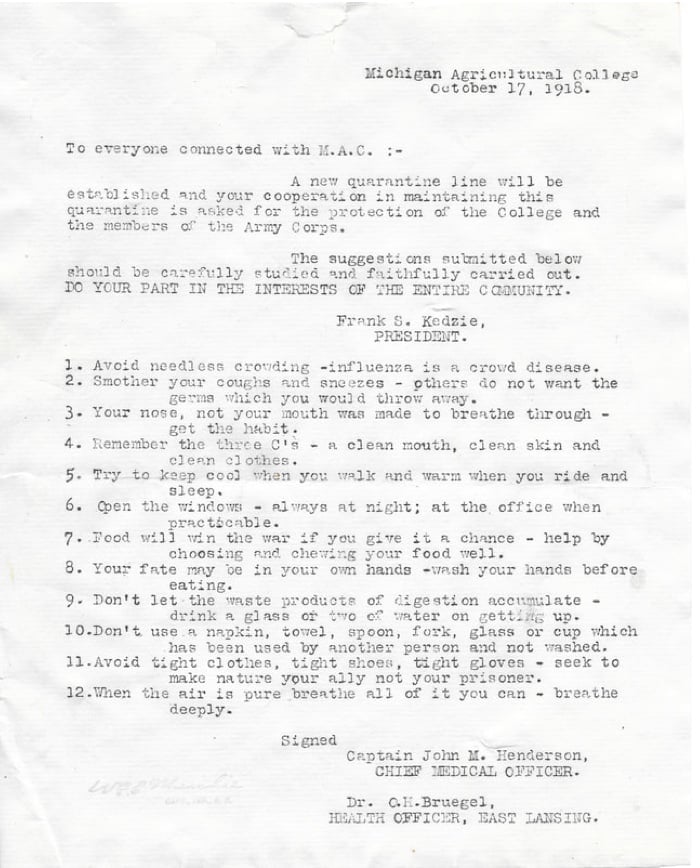
Special thanks to Neil Baron for his permission to use Dorothy Sweeney’s quarantine pass and President Kedzie’s letter. All other historical images are courtesy of Michigan State University Archives and Historical Collections.
Learn more about MSU's response to COVID-19


 Splendid work has been done by college men and women and military authorities, to care for the sick men of the SATC and check the spread of the epidemic of Spanish influenza. The small number of deaths so far speaks well for the effectiveness of their work and the energy and efficiency with which it has been accomplished. Everyone in the community has done his and her utmost in this emergency. Everywhere, service has been the watchword. Those who have watched the handling of the situation at the MAC camp will not require a trip overseas for a demonstration of what the Red Cross represents and the work that it can do. The Ingham County organization, including the East Lansing unit, have done wonderful work for the college during the past two weeks. Realizing that the boys of the SATC were as much entitled to their services as the men in the hospitals overseas, they came to our assistance at once and have helped mightily in organizing the hospital and caring for the sick men. They have taken care of the situation as no other organization could have done. They were able to put through orders and get materials and supplies, which could not have been obtained without their aid. In many instances their work alone has saved the situation. - The MAC Record, Oct. 25, 1918
Splendid work has been done by college men and women and military authorities, to care for the sick men of the SATC and check the spread of the epidemic of Spanish influenza. The small number of deaths so far speaks well for the effectiveness of their work and the energy and efficiency with which it has been accomplished. Everyone in the community has done his and her utmost in this emergency. Everywhere, service has been the watchword. Those who have watched the handling of the situation at the MAC camp will not require a trip overseas for a demonstration of what the Red Cross represents and the work that it can do. The Ingham County organization, including the East Lansing unit, have done wonderful work for the college during the past two weeks. Realizing that the boys of the SATC were as much entitled to their services as the men in the hospitals overseas, they came to our assistance at once and have helped mightily in organizing the hospital and caring for the sick men. They have taken care of the situation as no other organization could have done. They were able to put through orders and get materials and supplies, which could not have been obtained without their aid. In many instances their work alone has saved the situation. - The MAC Record, Oct. 25, 1918
 Gov. Gretchen Whitmer and Randolph Rasch, dean of the College of Nursing
Gov. Gretchen Whitmer and Randolph Rasch, dean of the College of Nursing

 An enlarged quarantine district is now established to include all of the campus except Faculty Row and the Women’s Building. The sentry lines run just south of the Faculty Row drive, east to Farm Lane, and south to the barns, then west to include the shops, Wells, and the new gymnasium. There are but two “ports of entry,” one between the post office and Abbot Hall and the other between the Women’s Building and the library. Absent-minded faculty members are brought up quickly with the sharp “halt” of the sentry if they wander from the beaten paths. — The MAC Record, Oct. 25, 1918
An enlarged quarantine district is now established to include all of the campus except Faculty Row and the Women’s Building. The sentry lines run just south of the Faculty Row drive, east to Farm Lane, and south to the barns, then west to include the shops, Wells, and the new gymnasium. There are but two “ports of entry,” one between the post office and Abbot Hall and the other between the Women’s Building and the library. Absent-minded faculty members are brought up quickly with the sharp “halt” of the sentry if they wander from the beaten paths. — The MAC Record, Oct. 25, 1918 Highlighted above: Every effort is being put forth at the MAC camp to control and stop the spread of the epidemic of Spanish influenza. On Wednesday, nearly 300 men were occupying the cots and lounging about the “base hospital” into which the new barrack buildings on the horticultural gardens have been turned. There are but very few severe cases, and not all of the 300 men confined are stricken with the influenza, many being there simply as a precautionary measure. — The MAC Record, Oct. 18, 1918
Highlighted above: Every effort is being put forth at the MAC camp to control and stop the spread of the epidemic of Spanish influenza. On Wednesday, nearly 300 men were occupying the cots and lounging about the “base hospital” into which the new barrack buildings on the horticultural gardens have been turned. There are but very few severe cases, and not all of the 300 men confined are stricken with the influenza, many being there simply as a precautionary measure. — The MAC Record, Oct. 18, 1918 From Oct. 11 to Oct. 18 the East Lansing women and college girls made and furnished to the SATC hospital 315 sheets, 293 pillowcases, 106 pajama suits, 72 pneumonia jackets, 623 handkerchiefs, 128 cubicles, 45 surgeons’ robes, 324 masks, 15 surgeons’ coats and 262 utility bags. The amount of material turned out in that time is little short of phenomenal, yet it only goes to demonstrate the spirit of the times and what Red Cross workers will do when there is need.— The MAC Record, Oct. 25, 1918
From Oct. 11 to Oct. 18 the East Lansing women and college girls made and furnished to the SATC hospital 315 sheets, 293 pillowcases, 106 pajama suits, 72 pneumonia jackets, 623 handkerchiefs, 128 cubicles, 45 surgeons’ robes, 324 masks, 15 surgeons’ coats and 262 utility bags. The amount of material turned out in that time is little short of phenomenal, yet it only goes to demonstrate the spirit of the times and what Red Cross workers will do when there is need.— The MAC Record, Oct. 25, 1918
 The home economics division of the college has very ably taken over much-needed work in connection with the handling of the influenza situation at MAC and has organized and is operating a dietetics kitchen in which food for all patients in the hospital is prepared and served. The senior domestic science girls are doing the work under the direction of Dean Edmonds and Misses Garvin and Clemens. Up until Saturday of last week the only provision made for feeding the sick men was through the regular boarding clubs. They were already overburdened with the task of preparing food for healthy soldiers and were unable to handle it properly. Then the girls stepped in and took over the task. — The MAC Record, Oct. 25, 1918
The home economics division of the college has very ably taken over much-needed work in connection with the handling of the influenza situation at MAC and has organized and is operating a dietetics kitchen in which food for all patients in the hospital is prepared and served. The senior domestic science girls are doing the work under the direction of Dean Edmonds and Misses Garvin and Clemens. Up until Saturday of last week the only provision made for feeding the sick men was through the regular boarding clubs. They were already overburdened with the task of preparing food for healthy soldiers and were unable to handle it properly. Then the girls stepped in and took over the task. — The MAC Record, Oct. 25, 1918